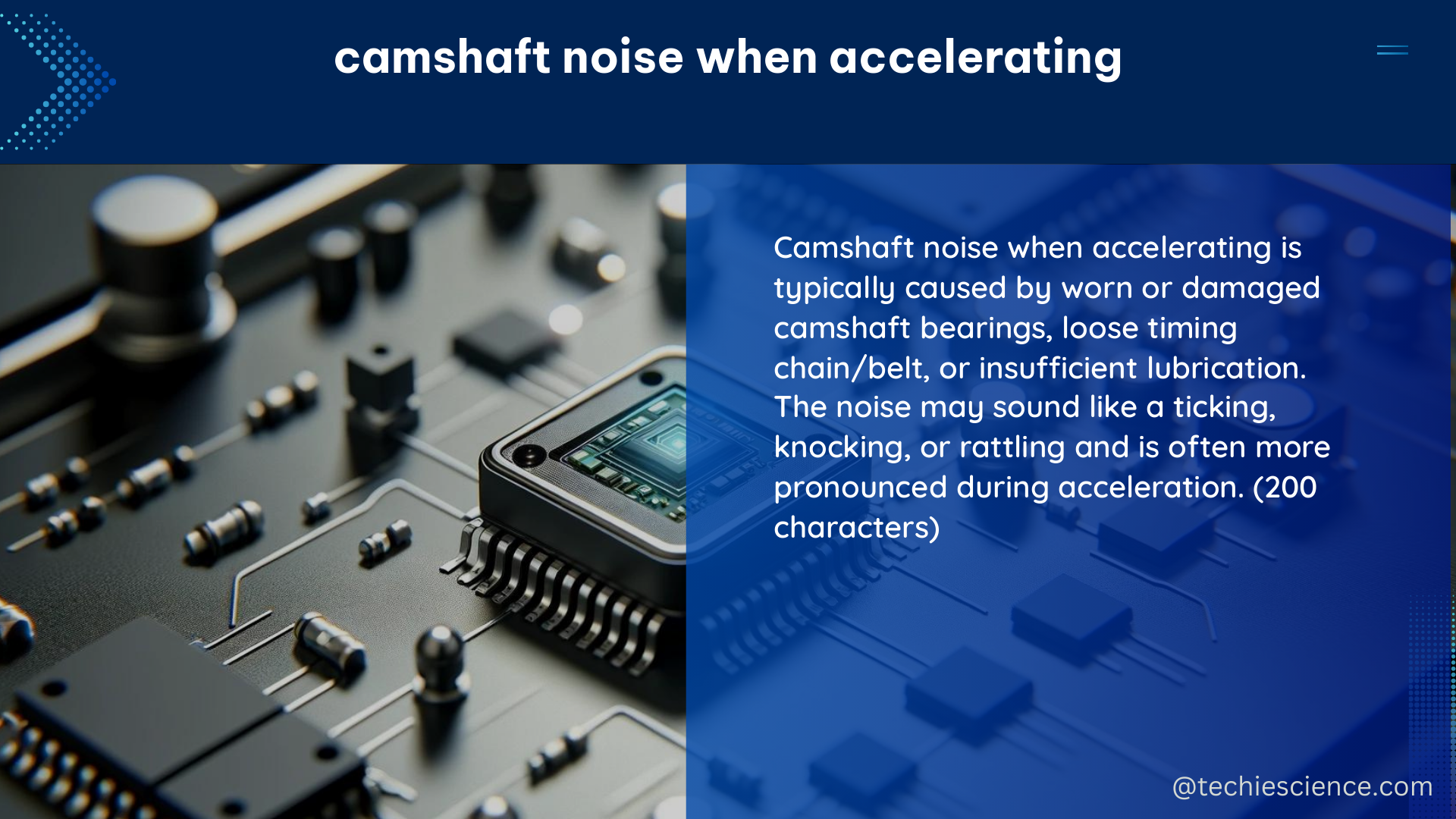Camshaft noise when accelerating is a common issue in internal combustion engines, and it can be caused by various factors such as wear, poor lubrication, or mechanical failure. To diagnose and address this problem, it is crucial to have a deep understanding of the engine’s technical specifications, as well as the specific measurements and data points related to camshaft noise.
Measuring Exhaust Flow Rate
One critical aspect of diagnosing camshaft noise is measuring the exhaust flow rate. According to a study on Black Carbon Measurement Methods and Emission Factors from Ships, FSN (Filter Smoke Number) measurements were taken during testing to determine the exhaust flow rate. This measurement is essential for understanding the engine’s performance and identifying any issues that may be causing excessive camshaft noise.
The study found that the exhaust flow rate can be influenced by various factors, such as engine load, engine speed, and fuel injection timing. For example, at higher engine loads and speeds, the exhaust flow rate tends to increase, which can lead to increased camshaft noise. Conversely, at lower engine loads and speeds, the exhaust flow rate may decrease, potentially reducing camshaft noise.
To measure the exhaust flow rate, the researchers used a specialized instrument called a smoke meter, which measures the opacity of the exhaust gas. The FSN value obtained from the smoke meter is directly proportional to the particulate matter concentration in the exhaust, and it can be used to calculate the exhaust flow rate. The researchers found that the FSN values ranged from 0.1 to 1.5, depending on the engine operating conditions.
Reviewing Maintenance Records

Another important factor to consider when diagnosing camshaft noise is the engine’s maintenance records. As stated in the SUPPLIER HANDBOOK DOCUMENT REVISION HISTORY TRACKER by Hitachi Automotive, maintenance records should be thoroughly reviewed to ensure that all pertinent statutory and regulatory requirements have been met.
This includes checking for any critical characteristics, such as air-tightness and screw fastening torque, that may impact the engine’s performance and contribute to camshaft noise. For example, if the engine’s air-tightness is compromised, it can lead to increased air intake and changes in the air-fuel ratio, which can in turn affect the engine’s performance and contribute to camshaft noise.
Additionally, the maintenance records should be checked for any previous repairs or replacements related to the camshaft or its associated components, such as the timing chain, tensioner, or bearings. Any issues with these components can contribute to camshaft noise and should be addressed accordingly.
Understanding Functional Characteristics
When it comes to addressing camshaft noise, it is crucial to have a clear understanding of the engine’s functional characteristics, including noise characteristics. According to Hitachi’s Supplier Handbook, noise characteristics are among the functional characteristics that require attention from the viewpoint of noise.
To address noise characteristics, it is important to identify the specific sources of noise within the engine, such as the camshaft, timing chain, or other moving components. This can be done through a combination of visual inspection, vibration analysis, and acoustic measurements.
Once the sources of noise have been identified, the next step is to address them through appropriate maintenance or repair procedures. This may involve replacing worn or damaged components, adjusting clearances, or implementing noise-reducing measures, such as the use of damping materials or vibration-isolating mounts.
Implementing DIY Solutions
In terms of DIY solutions, it is essential to follow the Production Part Approval Process (PPAP) outlined in Hitachi’s Supplier Handbook. This process involves submitting and identifying PPAP packages, trial part submissions, and new production components, as well as carefully reviewing releases and using the Fabrication Authorization and Material Authorization quantities to plan production and procurement requirements in advance of receipt of shipping orders.
When implementing DIY solutions, it is important to ensure that all replacement parts and components meet the engine manufacturer’s specifications and are compatible with the specific engine model. Failure to do so can lead to further issues and potentially exacerbate the camshaft noise problem.
Additionally, it is crucial to follow the recommended maintenance schedules and procedures outlined in the engine’s owner’s manual or service documentation. This includes regularly inspecting and replacing the camshaft, timing chain, and other related components as necessary to maintain the engine’s performance and minimize the risk of camshaft noise.
Conclusion
In summary, diagnosing and addressing camshaft noise when accelerating requires a deep understanding of the engine’s technical specifications, as well as specific measurements and data points related to camshaft noise. By measuring exhaust flow rate, reviewing maintenance records, and addressing noise characteristics, it is possible to identify and address the root cause of camshaft noise and improve the engine’s overall performance.
References:
– Black Carbon Measurement Methods and Emission Factors from Ships – https://theicct.org/sites/default/files/publications/Marine-BC-Testing_ICCT-UCR_Consultant-Report_16012017_vF.pdf
– SUPPLIER HANDBOOK DOCUMENT REVISION HISTORY TRACKER – https://www.hitachi-automotive.us/Supplier/Handbook/Supplier%20Handbook%20Condensed%2010.13.2021.pdf
– Greenhouse Gas Emissions Standards and Fuel Efficiency Standards for Medium- and Heavy-Duty Engines and Vehicles – https://unblock.federalregister.gov

The lambdageeks.com Core SME Team is a group of experienced subject matter experts from diverse scientific and technical fields including Physics, Chemistry, Technology,Electronics & Electrical Engineering, Automotive, Mechanical Engineering. Our team collaborates to create high-quality, well-researched articles on a wide range of science and technology topics for the lambdageeks.com website.
All Our Senior SME are having more than 7 Years of experience in the respective fields . They are either Working Industry Professionals or assocaited With different Universities. Refer Our Authors Page to get to know About our Core SMEs.